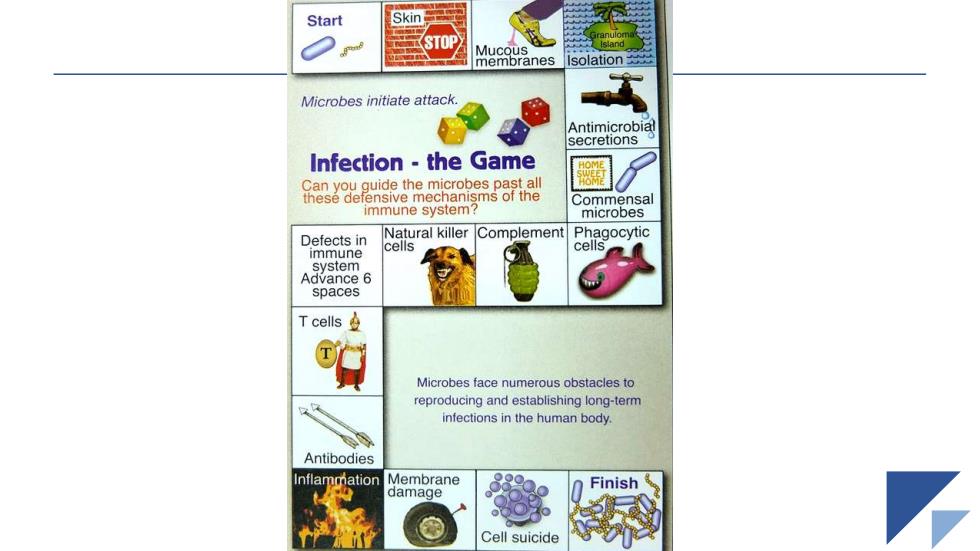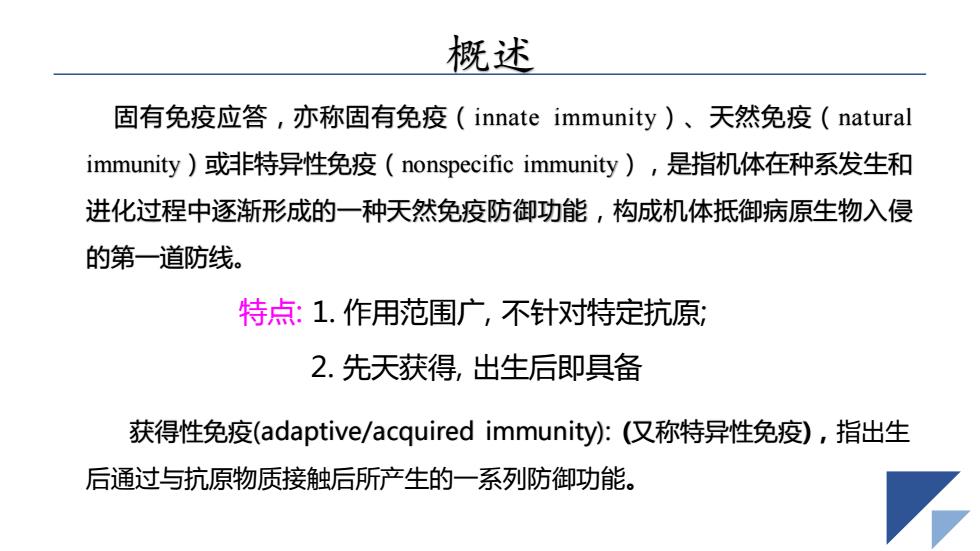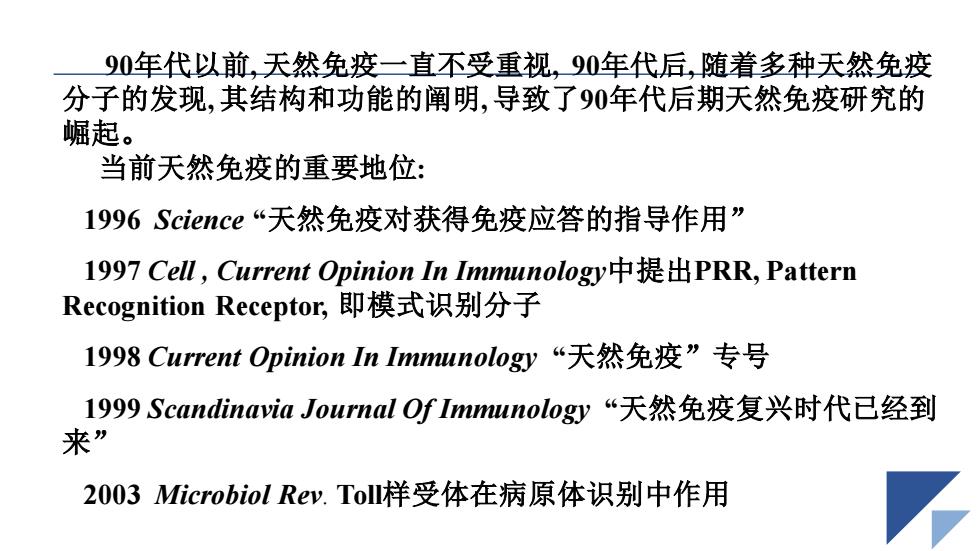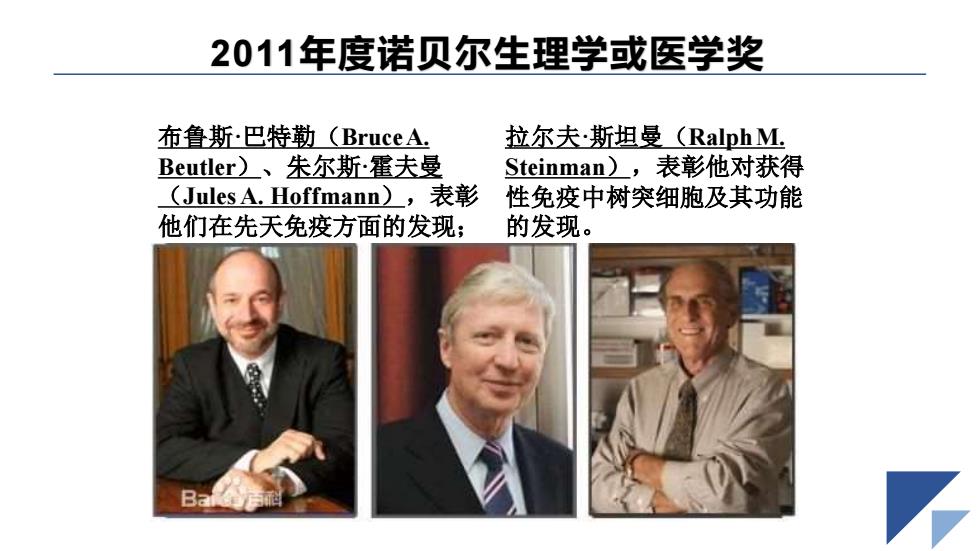
01 前 言
前 言

Threats to the individual Cancer Viruses Parasitic worms Fungi Bacteria Toxins latrogenic procedures
Threats to the individual

Protection from microbial invasion Outside the body Within the body Barriers Innate Adaptive Immune Immune Microbes: ·mechanical System System Microbes: hundreds few,if of billions ·chemical any biologic
Protection from microbial invasion

Start Skin Mucous membranes Isolation Microbes initiate attack Antimicrobial secretions Infection-the Game Can you guide the microbes past all these defensive mechanisms of the Commensa immune system? microbes Defects in Natural killer Complement Phagocytic cells cells immune system Advance 6 spaces T cells Microbes face numerous obstacles to reproducing and establishing long-term infections in the human body Antibodies Inflammation Membrane Finish damage Cell suicide

概述 固有免疫应答,亦称固有免疫(innate immunity)、天然免疫(natural immunity)或非特异性免疫(nonspecific immunity)),是指机体在种系发生和 进化过程中逐渐形成的一种天然免疫防御功能,构成机体抵御病原生物入侵 的第一道防线。 特点:1.作用范围广,不针对特定抗原: 2.先天获得,出生后即具备 获得性免疫(adaptive/acquired immunity):(又称特异性免疫),指出生 后通过与抗原物质接触后所产生的一系列防御功能
概述 固有免疫应答,亦称固有免疫(innate immunity)、天然免疫(natural immunity)或非特异性免疫(nonspecific immunity),是指机体在种系发生和 进化过程中逐渐形成的一种天然免疫防御功能,构成机体抵御病原生物入侵 的第一道防线。 特点: 1. 作用范围广, 不针对特定抗原; 2. 先天获得, 出生后即具备 获得性免疫(adaptive/acquired immunity): (又称特异性免疫),指出生 后通过与抗原物质接触后所产生的一系列防御功能

Phase of Immune response Innate Recognition immunity by preformed, Removal of Infection infectious (immediate: nonspecific 0-4 hours) effectors agent Early induced response Recruitment Recognition, Removal of activation of (early: Infection of effector infectious 4-96 hours) cells effector cells agent Adaptive Clonal immune Transport of antigen to Recognition expansion Removal of response Infection lymphoid by naive and infectious (late: differentiation organs B and T cells agent >96 hours) to effector cells
Phase of Immune Response

天然免疫与特异性免疫的识别特点的比较 识别特点 天然免疫 特异性免疫 识别抗原种类 仅识别微生物 既可识别微生物分子抗原 和靶分子结构 及其产物的组分(PNMP) 也可识别非微生物抗原 识别的特异性 泛特异性 高度特异性 识别不同种类的微生物 微生物的不同抗原表位 识别受体基因 在胚系中编码 在个体发育过程中重排 (BCR体细胞基因突变) 识别受体分布 非克隆化 克隆化

当前天然免疫的重要地位
当前天然免疫的重要地位

90年代以前,天然免疫一直不受重视,90年代后,随着多种天然免疫 分子的发现,其结构和功能的阐明,导致了90年代后期天然免疫研究的 崛起。 当前天然免疫的重要地位: 1996 Science“天然免疫对获得免疫应答的指导作用” 1997Cell,Current Opinion In Immunology中提出PRR,Pattern Recognition Receptor,,即模式识别分子 1998 Current Opinion In Immunology“天然免疫”专号 1999 Scandinavia Journal Of Immunology“天然免疫复兴时代已经到 来” 2003 Microbiol Rev.Toll样受体在病原体识别中作用
90年代以前, 天然免疫一直不受重视, 90年代后, 随着多种天然免疫 分子的发现, 其结构和功能的阐明, 导致了90年代后期天然免疫研究的 崛起。 当前天然免疫的重要地位: 1996 Science “天然免疫对获得免疫应答的指导作用” 1997 Cell , Current Opinion In Immunology中提出PRR, Pattern Recognition Receptor, 即模式识别分子 1998 Current Opinion In Immunology “天然免疫”专号 1999 Scandinavia Journal Of Immunology “天然免疫复兴时代已经到 来” 2003 Microbiol Rev. Toll样受体在病原体识别中作用

2011年度诺贝尔生理学或医学奖 布鲁斯:巴特勒(Bruce A. 拉尔夫,斯坦曼(Ralph M. Beutler)、朱尔斯:霍夫曼 Steinman),表彰他对获得 (Jules A.Hoffmann),表彰 性免疫中树突细胞及其功能 他们在先天免疫方面的发现; 的发现
2011年度诺贝尔生理学或医学奖 布鲁斯·巴特勒(Bruce A. Beutler)、朱尔斯·霍夫曼 (Jules A. Hoffmann),表彰 他们在先天免疫方面的发现; 拉尔夫·斯坦曼(Ralph M. Steinman),表彰他对获得 性免疫中树突细胞及其功能 的发现